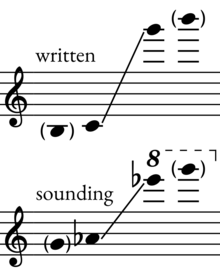| Woodwind | |
|---|---|
| Other names | Czakan, Csákány, Tsákány, Flûte douce |
| Classification |
|
| Hornbostel–Sachs classification | 421.221.12 (Flute with internal duct and finger holes) |
| Inventor(s) | Anton Heberle? |
| Developed | c.1806 from the recorder and Eastern European folk flutes |
| Playing range | |
 | |
| Related instruments | |
The csakan is a type of woodwind instrument that was popular in Austria-Hungary in the 19th century.[1]
A type of duct flute, the csakan was originally a recorder crafted in the shape of a walking stick with a mouthpiece in the handle, reflecting the design of Hungarian war hammers which had been converted into flutes.[1][2] From the 1820s, a new design appeared, which was in the shape of an oboe or clarinet.[1][3]
The csakan is a transposing instrument in A-flat although it could also be considered a transposing instrument in A when used with guitars which were almost always tuned a semitone down when accompanying the csakan.[4] Modern manufacturers refer to it as "the Romantic recorder".[5]
Octaving is achieved on the csakan in the same manner as the recorder, that is by partially opening the thumb hole to allow it to act as a register vent. However, csakans were sometimes equipped with a removable bushing for the thumbhole which would create the correct opening size with the thumb removed from the hole. This necessitates the use of overblown fingerings for C♯5 and D5 which would otherwise be produced from the thumb hole.[4]
- ^ a b c Betz, Marianne (2001). "Csakan". Grove Music Online (8th ed.). Oxford University Press. doi:10.1093/gmo/9781561592630.article.06917. ISBN 978-1-56159-263-0.
- ^ Tarasov, Nikolaj (2009). "Was ist ein Csakan? Von der Waffe zum Musikinstrument" [What is a csakan? From war hammer to musical instrument]. Windkanal (1): 14–19. ISSN 1864-6204.
- ^ Reyne, Hugo (2009). Viennoiseries musicales. (Booklet) Portland, Oregon, USA: Allegro Corporation.
- ^ a b Schaller, Helmut. "Der Csakan bei Ernest Krähmer" (PDF). Wiener Oboen-Journal.
- ^ "Csakan – the recorder from the 19th century". www.csakan.de. Archived from the original on 13 July 2021. Retrieved 13 July 2021.
